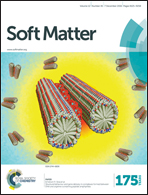The effect of confinement on the electrohydrodynamic behavior of droplets in a microfluidic oil-in-oil emulsion†
Abstract
A two-fluid emulsion (silicone oil drops in the “leaky dielectric”, castor oil) with electrohydrodynamically driven flows can serve as a model system for tunable studies of hydrodynamic interactions [Varshney et al., Sci. Rep., 2012, 2, 738]. Flows on multiple length- and time-scales have been observed but the underlying mechanism for these chaotic, multi-scale flows is not understood. In this work, we conducted experiments varying the thickness of the test cell to examine the role of substrate interactions on size distribution, mean square displacement and velocity of the drops as a function of the electric field strength. We find that the electric capillary number, CaE, at the threshold of drop breakup is of order unity for cell thicknesses of 100 μm or thicker, but much larger for thinner cells. Above this threshold, there is a clear transition to super-diffusive droplet motions. In addition, we observe that there is a convective instability prior to the onset of chaotic flows, with the lengthscale associated with the convection rolls increasing linearly with an increase in the cell thickness. The fact that the convective instability appears to occur in the leaky dielectric castor oil regardless of whether the second component is liquid drops, solid particles, or dissolved dye has implications on the underlying mechanism for the unsteady flows.



 Please wait while we load your content...
Please wait while we load your content...